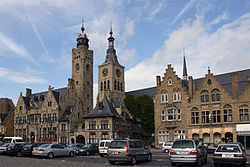Country Belgium Area codes 051 Area 149.4 km² Local time Tuesday 6:52 PM Area code 051 | Postal codes 8600 Website www.diksmuide.be Postal code 8600 | |
 | ||
Weather 7°C, Wind W at 5 km/h, 88% Humidity Arrondissement Arrondissement of Diksmuide | ||
Diksmuide ( [ˌdɪksˈmœy̯də]; French: Dixmude, West Flemish: Diksmude) is a Belgian city and municipality in the Flemish province of West Flanders. The municipality comprises the city of Diksmuide proper and the former communes of Beerst, Esen, Kaaskerke, Keiem, Lampernisse, Leke, Nieuwkapelle, Oostkerke, Oudekapelle, Pervijze, Sint-Jacobs-Kapelle, Stuivekenskerke, Vladslo and Woumen.
Contents
- Map of 8600 Diksmuide Belgium
- Medieval origins
- World War I
- Sights
- Notable inhabitants
- Twin cities
- References
Map of 8600 Diksmuide, Belgium
Most of the area west of the city is a polder riddled with drainage trenches. The major economic activity of the region is dairy farming, producing the famous butter of Diksmuide.
Medieval origins
The 9th-century Frankish settlement of Dicasmutha was situated at the mouth of a stream near the Yser (Dutch: IJzer). The name is a compound of Dutch dijk (dike) and muide (river mouth). By the 10th century, a chapel and market place were already established. The city’s charter was granted two centuries later and defensive walls built in 1270. The economy was already then based mainly on agriculture, with dairy products and linen driving the economy. From the 15th century to the French Revolution, Diksmuide was affected by the wars between the Netherlands, France, Spain, and Austria, with a corresponding decline in activity. The 19th century was more peaceful and prosperous.
World War I
At the outset of World War I, German troops crossed the Belgian border near Arlon, then proceeded hurriedly towards the North Sea to secure the French ports of Calais and Dunkirk. The Battle of the Yser started in October 1914. Thanks to the water the Belgians were able to stop the Germans; at the end of October, they opened the flood gates holding back the Yser river and flooded the area. As a result, the river became a front line throughout the First World War. The city was first attacked on October 16, 1914 and defended by Belgian and French troops, which marked the beginning of the battle. Colonel Alphonse Jacques led the troops that prevented Diksmuide from being taken by the German Army. Despite the heavy Belgian losses, the press, politicians, literary figures and the military itself created propaganda which formed public opinion into making the action look strategic and heroic.
By the time the fighting ended, the town had been reduced to rubble. It was, however, completely rebuilt in the 1920s.
